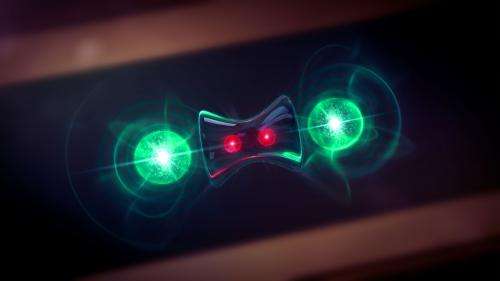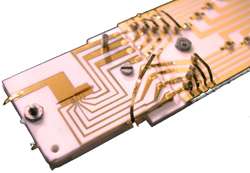How losing information can benefit quantum computing

Suggesting that quantum computers might benefit from losing some data, physicists at the National Institute of Standards and Technology (NIST) have entangled—linked the quantum properties of—two ions by leaking judiciously chosen information to the environment.
Researchers usually strive to perfectly shield ions (charged atoms) in quantum computing experiments from the outside world. Any "noise" or interference, including heat generated by the experiment and measurements that cause fragile quantum states to collapse, can ruin data and prevent reliable logic operations, the conventional approach to quantum information processing.
Turning bug into feature, a collaboration of physicists from NIST and the University of Copenhagen in Denmark decided to think and work outside the box. They cleverly linked the experiment to the outside world to establish and maintain the entanglement of two ions. Entanglement is a curious feature of the quantum world that will be necessary to process and transport quantum data or correct errors in future quantum computers.
The new research is described in a Nature paper posted online Nov. 24, along with similar work at Yale University using superconducting circuits.
"These new methods might be used to create entangled states that would be a resource in a traditional, logic-based quantum computer," NIST postdoctoral researcher John Gaebler says. "But there are also alternative architectures in which, for example, one couples a quantum computer to a specific noise environment and the resulting state of the computer contains the solution to the target problem."
The NIST experiments used two beryllium ions as quantum bits (qubits) to store quantum information and two partner magnesium ions, which were cooled with three ultraviolet laser beams to release heat.
The qubits were entangled by two ultraviolet laser beams and induced to "leak" any unwanted quantum states to the environment through continuous application of microwaves and one laser beam. The unwanted data were coupled to the outgoing heat in such a way that the qubits were left in only the desired entangled state—which happens to be the point of lowest motional energy, where no further heat and information is released to the environment.

Unlike a logic operation, the process can be started from any state of the ions and still yield the same final state. The scheme also can tolerate some kinds of noise that might cause a traditional logic gate to fail. For instance, the lasers and microwaves had no negative effects on the target entangled state but reshuffled any unwanted states.
All operations applied at the same time quickly drove the two qubits into a specific entangled state and kept them in that state most of the time. The qubits approached the target state within a few milliseconds and were found to be in the correct entangled state 75 percent of the time. The qubit state deteriorated slightly over longer times as the qubits were disturbed by errant laser emissions. By applying about 30 repetitions of the four steps in a particular order, scientists boosted the success rate to 89 percent in a separate experiment.
More information: Y. Lin, J.P. Gaebler, F. Reiter, T.R. Tan, R. Bowler, A.S. Sorensen, D. Leibfried and D.J. Wineland. Dissipative production of a maximally entangled steady state. Nature. Posted online Nov. 24, 2013.
Journal information: Nature
Provided by National Institute of Standards and Technology




















